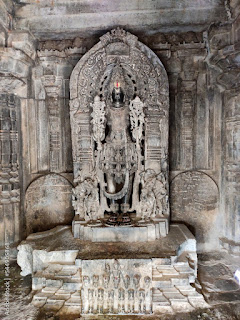 |
| Vedic Hindu Sun God SURYA (ADITHYA) dreamstime.com |
 |
| Vedic Hindu Sun god Surya, Pinterest.com |
Above image: Surya, in Hinduism, both the Sun and the Sun god in the Vedic period (1500–5th century BCE) was once ranked along with Vishnu, Shiva, Shakti, and Ganesha, and many temples dedicated to him are found throughout India. Those five deities are worshipped by a group of Brahmans (priests), the Smartas, but only a small group, the Saura sect, worships Surya as the supreme deity. He is, however, invoked by most Hindus, and the Gayatri mantra, uttered daily at dawn by many Hindus, is addressed to the Sun...........................
Sun Worship
Sun worship holds a unique position in the religious traditions of South India, where the Sun God, known as Surya, is revered as a powerful celestial being representing energy, health, and prosperity. While the worship of Surya is not as widespread in South India as in the northern parts of the country, it still has a significant cultural and spiritual impact. Surya is invoked daily during sunrise rituals and through traditional practices like the Surya Namaskar and recitation of hymns such as the Aditya Hridayam. Let’s explore the presence of Sun worship and prominent Sun temples across the major South Indian states. This post covers some Sun temples only.
Tamil Nadu: Suryanar Kovil and Thanjavur’s Solar Connections
 |
| Suryanar Kovil near Kumbakonam, TN rawell.in |
Nearest bus and railway station: KUmbakonam city on the main line.
Another lesser-known Sun temple is the Vivasvan Sun Temple in Kumbakonam, which has a long-standing association with Surya worship. The architectural layout of the temple ensures that during the equinoxes, the first rays of the Sun illuminate the main deity, symbolizing the convergence of celestial forces.
Andhra Pradesh: Arasavalli Sun Temple
.jpg) |
| Arasavalli Sun Temple, Srikakulam,AP upload.wikimedia.org |
Located one km from Srikakulam town, this shrine can be reached through roads and railways.
Karnataka: Sun Worship in Pattadakal and Aihole
 |
| Sun god, Virupaksha temple, yatrikaone.com |
 |
| sun god with a 7 horse chariot Hoysaleswara temple Halebidu, KA 1.ftcdn.ne |
Above image: The Hoysaleswara temple (12th CE), Halebidu of Karnataka state encomposes two temples dedicated to Hoysaleswara and Santaleswara Shiva lingas, named after the masculine and feminine aspects of Shiva. The temple includes a smaller sanctum for the Vedic Hindu Sun god Surya............
Karnataka, known for its architectural treasures, showcases traces of Sun worship in temples like those at Pattadakal and Aihole, which were constructed during the early Chalukya dynasty. While there are no standalone Sun temples here, Surya is often depicted as a secondary deity in various temple sculptures, signifying his importance within the pantheon of gods. In these temples, the carvings show Surya riding his chariot pulled by seven horses, flanked by his two wives, Usha and Pratyusha, and accompanied by celestial beings. Temples of Pattadakal and Aihole came up in the 7th and 8th CE.
These places are well connected by road. Nearest city is Hassan. Airport: Bengaluru about 130 miles. There are many tourist operators from Mysore, Hassan and other places.
Kerala: Adityapuram and Surya Namaskar Traditions
 |
| The Adityapuram Sun Temple,Vaikom ,Kerala/upload.wikimedia.org |
Kerala’s connection to Surya worship is mostly ritualistic, with the daily practice of offering water to the rising Sun being common. The Adityapuram Sun Temple, located near Vaikom in Kottayam district, is one of the few temples exclusively dedicated to Surya in the state. This ancient temple, believed to be over a thousand years old, attracts devotees seeking relief from ailments and seeking blessings for success and prosperity. The annual Ratha Saptami festival and the Makara Sankranti rituals are celebrated with great fervor, involving the traditional Seeveli procession and Surya puja. Nearest railway station: Kottayam, about 26 km and Nearest airport: Cochin International Airport, about 47 km
Sun Worship in Modern Times
In South India, modern practices of Sun worship are often integrated into the daily routines of yoga and health regimens, where the Surya Namaskar serves as a physical and spiritual exercise. The worship of Surya, although less prominent compared to other deities, continues to be observed through rituals, festivals, and temple visits, highlighting his enduring significance in the spiritual life of the region.
In conclusion, the Sun temples in South India, though fewer in number, are architectural marvels and represent a profound connection between the cosmic forces and spiritual traditions of the land. They stand as testament to the age-old reverence for Surya, the eternal source of energy, life, and enlightenment.
https://wwwhttps:https://en.wikipedia.org/wiki/Hoysaleswara_Temple
https://yatrikaone.com/india-halebidu-hoysalesvara-temple-suryastatue/.keralatourism.org/destination/surya-temple-adityapuram/48









